In today’s fast-paced world, smartphones have become an integral part of our daily routine. Gone are the days when they were simply used for making calls and sending texts. Now, they have evolved into multifaceted devices that offer a host of features and capabilities.
One such feature is the ability to access voicemails, which are recorded messages left by callers when you are unable to answer a call. This can be incredibly useful, particularly for those who rely heavily on communication in their professional lives. Voicemails provide a convenient way to stay connected and informed, even when you are unavailable.
Table of Contents
Voicemail Greetings & Phone Message Templates
Make a lasting impression and leave callers with a warm welcome using our diverse collection of Voicemail Greetings Templates. Crafting a compelling voicemail greeting is crucial for setting a professional tone and ensuring callers feel valued and attended to. Our customizable and creatively designed templates provide a range of options to suit various purposes, from personal voicemail greetings to professional business messages.
Whether you’re an individual managing personal calls or a business owner seeking a polished and engaging voicemail greeting, our templates offer an array of styles and tones to match your unique personality or brand image. With our user-friendly templates, you can easily customize your voicemail greeting with a warm introduction, clear instructions, and a friendly closing message. Captivate callers, enhance your professional image, and leave a lasting impression with our versatile and easy-to-use Voicemail Greetings Templates. Download now and transform your voicemail into an impactful and engaging communication tool.
Key Elements of a Phone Message Template

A phone message template should include the following elements:
Date and time of the message: This helps the recipient to know when the message was left.
Caller’s name and contact information: This allows the recipient to know who the message is from and how to contact them back.
Purpose of the call: This provides the recipient with an idea of why the caller is trying to reach them.
Urgency of the call: This lets the recipient know whether the call is important or if it can be returned at a later time.
Call-back instructions: This includes the best time to reach the caller and their preferred contact method (phone, email, etc.).
Confirmation of message receipt: This lets the caller know that their message has been received and will be acted upon.
It’s also recommended that the template should be concise and easy to understand, and should also be formatted in a way that is easy to read and take notes on.
Benefits of a Phone Message Template
There are several benefits to using a phone message template:
Consistency
Using a template ensures that all messages are formatted in the same way, making it easy for the recipient to quickly identify important information and respond accordingly.
Efficiency
A phone message template saves time by providing a pre-formatted structure for taking messages, allowing the person taking the message to focus on capturing important information.
Clarity
A template helps to ensure that all important information is included in the message, which minimizes the risk of important details being left out.
Professionalism
Using a template for phone messages can create a more professional image for your business, as it shows that you have a system in place for managing and responding to incoming calls.
Better communication
By providing clear and concise messages, recipients are able to quickly understand the purpose of the call and respond in a timely manner, which can improve communication and customer satisfaction.
Improved organization
A phone message template allows you to keep track of all the important information received in a call and can be used as a reference in future communications.
Improved follow-up
Having a standardized template for phone messages makes it easy to keep track of all incoming calls, which can help ensure that follow-up calls and emails are made in a timely and organized manner.
Reducing errors
A phone message template eliminates the chances of errors caused by missing or misinterpreted information, which can help to ensure that the right message is being conveyed.
Better customer service
By providing clear and concise messages, recipients are able to quickly understand the purpose of the call and respond in a timely manner, which can improve communication and customer satisfaction.
Cost-effective
Using a phone message template can help to reduce the time and resources required to manage and respond to incoming calls, which can help to lower overall costs for your business.
Easy to update
Phone message template can be easily updated as per the requirement of the organization and its changing needs, it’s also easy to train new employees to use it.
Data analysis
Phone message template can be used to analyze the customer’s data, which can help to identify patterns and trends in customer behavior, which can be used to improve customer service and make better business decisions.
Effective Phone Message Taking Strategies
Be prepared: Have a pen and paper or a computer ready to take notes, and make sure that you are in a quiet place where you can hear and speak clearly.
Greet the caller: Start the conversation by introducing yourself and your organization in a friendly and professional manner.
Listen carefully: Pay close attention to the caller’s message, and ask for clarification if you are unsure of any details.
Take accurate notes: Record the caller’s name, contact information, and the purpose of their call, as well as any other important details they provide.
Confirm the message: Repeat the message back to the caller to ensure that you have recorded it correctly.
Provide call-back instructions: Let the caller know the best time to reach the intended recipient and the preferred contact method.
Thank the caller: End the call by thanking the caller for their message and letting them know that their message will be delivered promptly.
Follow-up: Make sure to follow-up on the message as soon as possible and make sure that the recipient of the message is aware of its content.
Keep it professional: Always maintain a professional and courteous tone throughout the conversation, even if the caller is upset or difficult to understand.
Keep the message brief and clear, avoid using jargon or complex terms that might be hard to understand, keep it simple and easy to follow.
Alternatives for Voicemail Greeting Templates
Professional Greeting: A standard, professional greeting that includes the company name, your name, and a brief message about when the caller can expect a return call.
Personal Greeting: A personalized greeting that includes your name, a brief message about what you’re currently doing (e.g. “I’m currently out of the office”), and an estimated time of return.
Out of Office Greeting: A specific greeting that is used when you are out of the office, providing the caller with an alternate contact and expected return date.
Holiday Greeting: A special greeting that is used during holidays, providing the caller with information about office hours and availability during the holiday period.
After-hours Greeting: A greeting that is used outside of regular office hours, providing the caller with information about when the office will be open again and an alternate contact if necessary.
Language Greeting: A greeting tailored to the caller’s language, providing the caller with an option to select the language they prefer to communicate in.
Emergency Greeting: A specific greeting that is used in case of emergency, providing the caller with important contact information and instructions on how to reach someone in case of urgent matter.
On-Call Greeting: A greeting that is used by an on-call staff member, providing the caller with the name of the person currently on call, and their contact information.
Key Elements of Good Voicemail Greetings
Introduction: Start with a clear and friendly introduction, including your name and the name of the company you are representing.
Purpose: Clearly state the purpose of your voicemail message, such as returning a call or providing information.
Availability: Let the caller know your availability, such as your regular business hours or when they can expect a return call.
Alternate contact: Provide an alternate contact or method of getting in touch, in case the caller needs to reach you urgently.
Professionalism: Maintain a professional tone throughout the message and avoid using slang or casual language.
Clarity: Speak clearly and at a moderate pace, and avoid background noise or distractions.
Call-to-action: End the message with a call-to-action, such as asking the caller to leave a message or providing instructions for what to do next.
Repeat your phone number: Repeat your phone number at the end of the message, so the caller can confirm that they have the correct number.
Keep it short: Keep your voicemail greeting brief and to the point, ideally under 30 seconds.
Update it frequently: Regularly update your voicemail greeting to keep it current and accurate.
Types of Voicemail Greetings with Examples
Professional Greeting: “Hello, you’ve reached XYZ Company. This is John Smith. I’m sorry I’m unable to take your call at the moment. Please leave your name, number and a brief message, and I’ll return your call as soon as possible. Thank you.”
Personal Greeting: “Hey there, it’s John Smith. I’m currently out for a run, but I’ll be back in the office in about an hour. Leave a message and I’ll get back to you as soon as I can.”
Out of Office Greeting: “Hello, this is John Smith. I’m currently out of the office until the end of next week. For urgent matters, please contact Jane Doe at 555-555-5555. I’ll return your call as soon as possible. Thank you.”
Holiday Greeting: “Happy holidays from XYZ Company! Our office is currently closed for the holiday season, but we’ll be back in the office on January 2nd. Leave a message and we’ll get back to you as soon as possible. Thank you!”
After-hours Greeting: “Hello, you’ve reached XYZ Company. Our office is currently closed, but we’ll be back in the office at 8:00 am tomorrow. For urgent matters, please contact John Smith at 555-555-5555. Leave a message and we’ll get back to you as soon as possible. Thank you.”
Language Greeting: “Bonjour, vous avez atteint XYZ Company. Je suis désolé, je ne parle pas français. Pour des questions en français, s’il vous plaît appeler Jane Doe au 555-555-5555. Laissez un message et je vous rappellerai dès que possible. Merci.”
Emergency Greeting: “Hello, this is an emergency voicemail for XYZ Company. In case of emergency, please contact John Smith at 555-555-5555. Thank you”
On-Call Greeting: “Hello, you’ve reached XYZ Company. This is John Smith, I am currently on call. Please leave your name, number and a brief message, and I’ll return your call as soon as possible. Thank you.”
Automated Attendant Greeting: “Thank you for calling XYZ Company. Please press 1 for sales, 2 for customer service, 3 for technical support, or 4 for our directory. To speak with a representative, please hold. Thank you for your call.”
Voicemail Only Greeting: “Hello, you’ve reached John Smith’s voicemail. I’m currently unable to take your call, but please leave a message and I’ll get back to you as soon as I can. Thank you.”
Forwarded Call Greeting: “Hello, you’ve reached John Smith’s voicemail. I’m currently out of the office, but my calls are being forwarded to Jane Doe at 555-555-5555. Please leave a message and she’ll be happy to assist you. Thank you.”
Event Greeting: “Hello, you’ve reached XYZ Company. We’re currently experiencing high call volume due to our upcoming event. Please leave your name, number, and a brief message and we’ll return your call as soon as possible. Thank you for your patience.”
Personalized Greeting: “Hello, this is John Smith, I’m currently on the other line, but I’ll get back to you as soon as possible. Leave your name, number, and a brief message, and I’ll be sure to call you back. Thank you.”
Group Greeting: “Hello, you’ve reached the voicemail of John Smith and Jane Doe, We’re currently unavailable to take your call. Please leave your name, number and a brief message and we’ll get back to you as soon as possible. Thank you.”
Multi-Lingual Greeting: “Hello, you’ve reached XYZ Company. Please press 1 for English, 2 for Spanish, 3 for Chinese and 4 for French. A representative will be with you shortly. Thank you for your call.”
FAQs
What should a phone message include?
A phone message should include the date, time, caller’s name, company/relationship, return number, brief reason for call, and any action requested. The recipient’s name should be at the top.
What is a message template?
A message template is a pre-made form with fields to capture key details when taking a phone message, such as caller name, company, number, date/time, reason for call, and actions needed. It provides a consistent structure for recording messages.
How do you write a telephone message?
When taking a telephone message:
- Write down the date and time of the call at the top
- Get the caller’s full name, company/relationship
- Note their return phone number
- Briefly summarize the reason for the call
- Indicate any action requested by the caller
- Mark the message urgent if specified
How do you fill out a phone call slip?
To fill out a phone call slip:
- Write your name and the date at the top
- Enter the name of the person you are calling
- Include their company and phone number
- Briefly state the purpose/reason for call
- Leave sections blank for date, time, and notes.
What is a good greeting for voicemail?
Some good greetings for a voicemail are:
“Hi, this is [your name].”
“Hello, you’ve reached [your name]’s voicemail.”
“Thank you for calling [your name].”
Short and simple greetings are recommended to get quickly to the message.
What is the template for personal voicemail?
A template for a personal voicemail greeting is:
“Hi, this is [your name]. I’m sorry I missed your call. Please leave your name, number, and a brief message after the tone and I’ll get back to you as soon as possible. Thanks!”
What is a brief voicemail greeting example?
Here is an example of a brief voicemail greeting:
“Hi, this is John Smith. Please leave a message with your name and number. I’ll return your call shortly. Thanks.”
How do you script a voicemail?
To script a voicemail:
- Open with a friendly salutation.
- State your name clearly.
- Give instructions for leaving a message.
- Repeat your name and number.
- Thank them and end recording.
Keep it short and practice until it sounds natural.

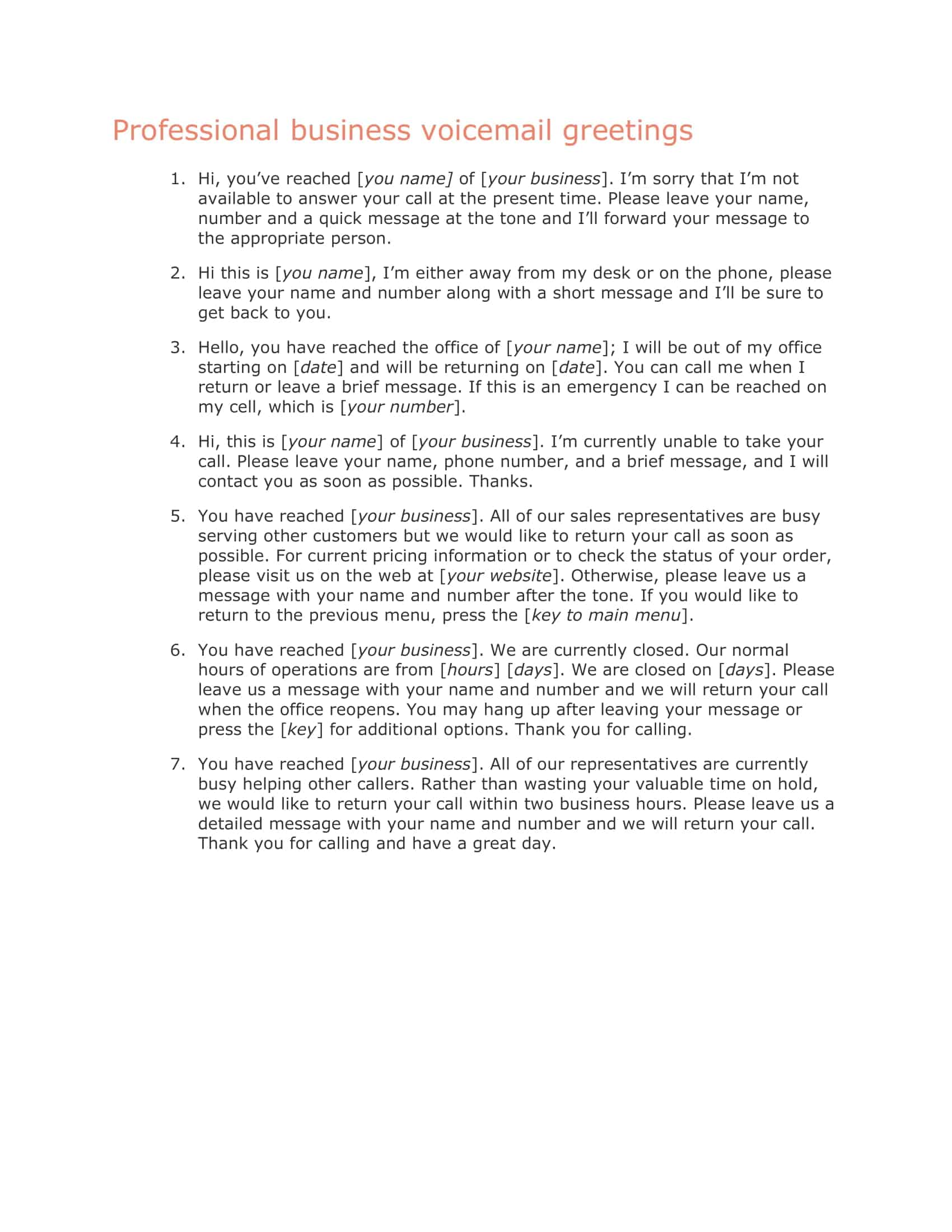
























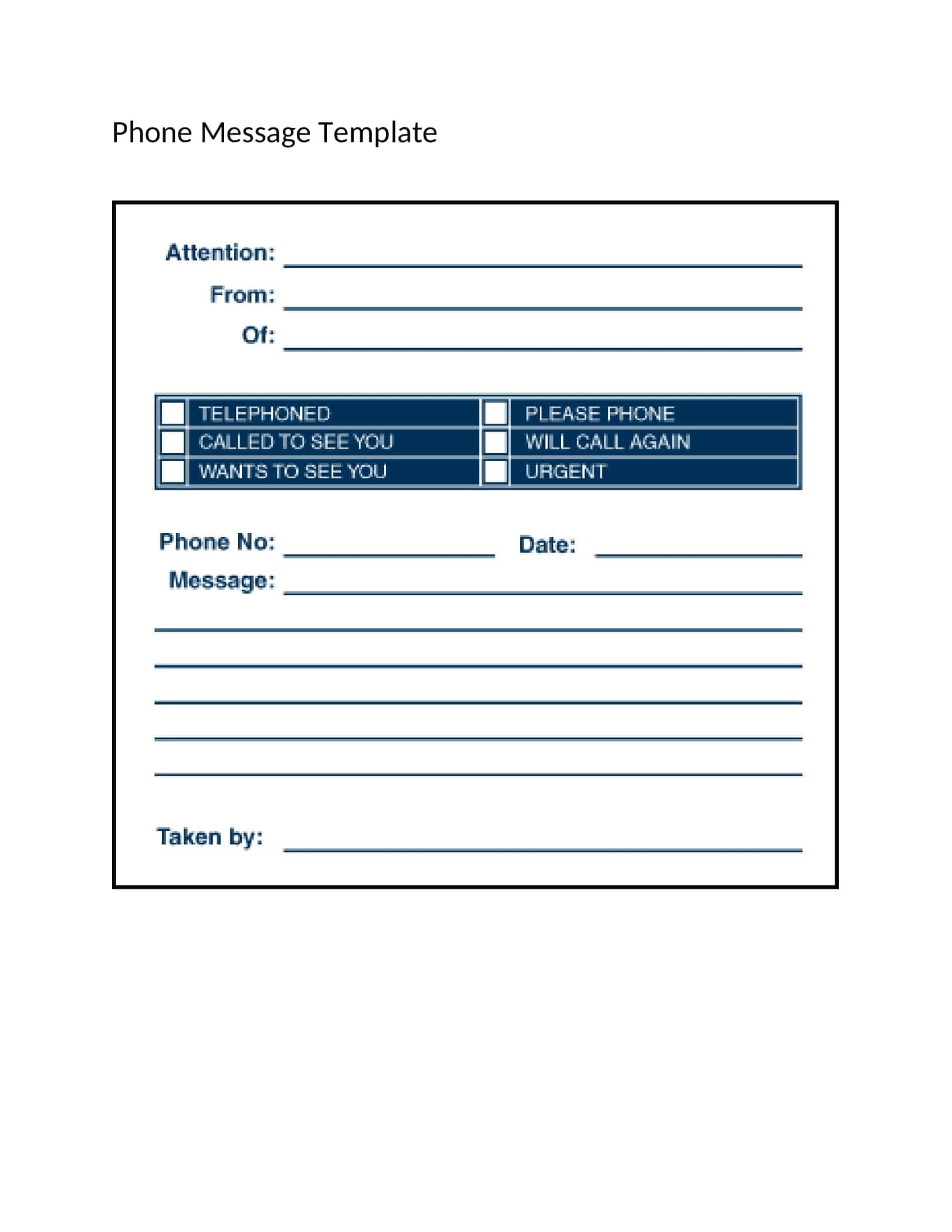



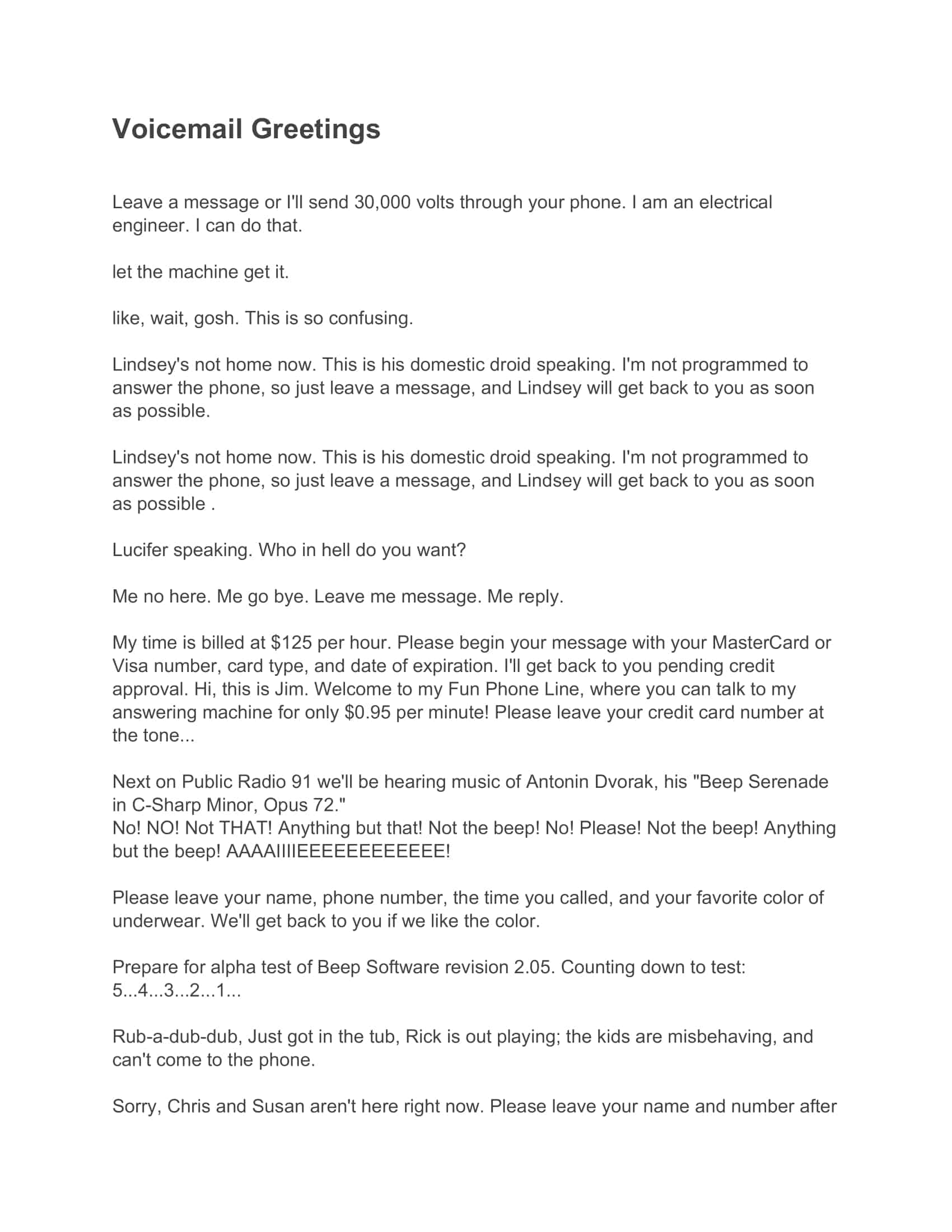






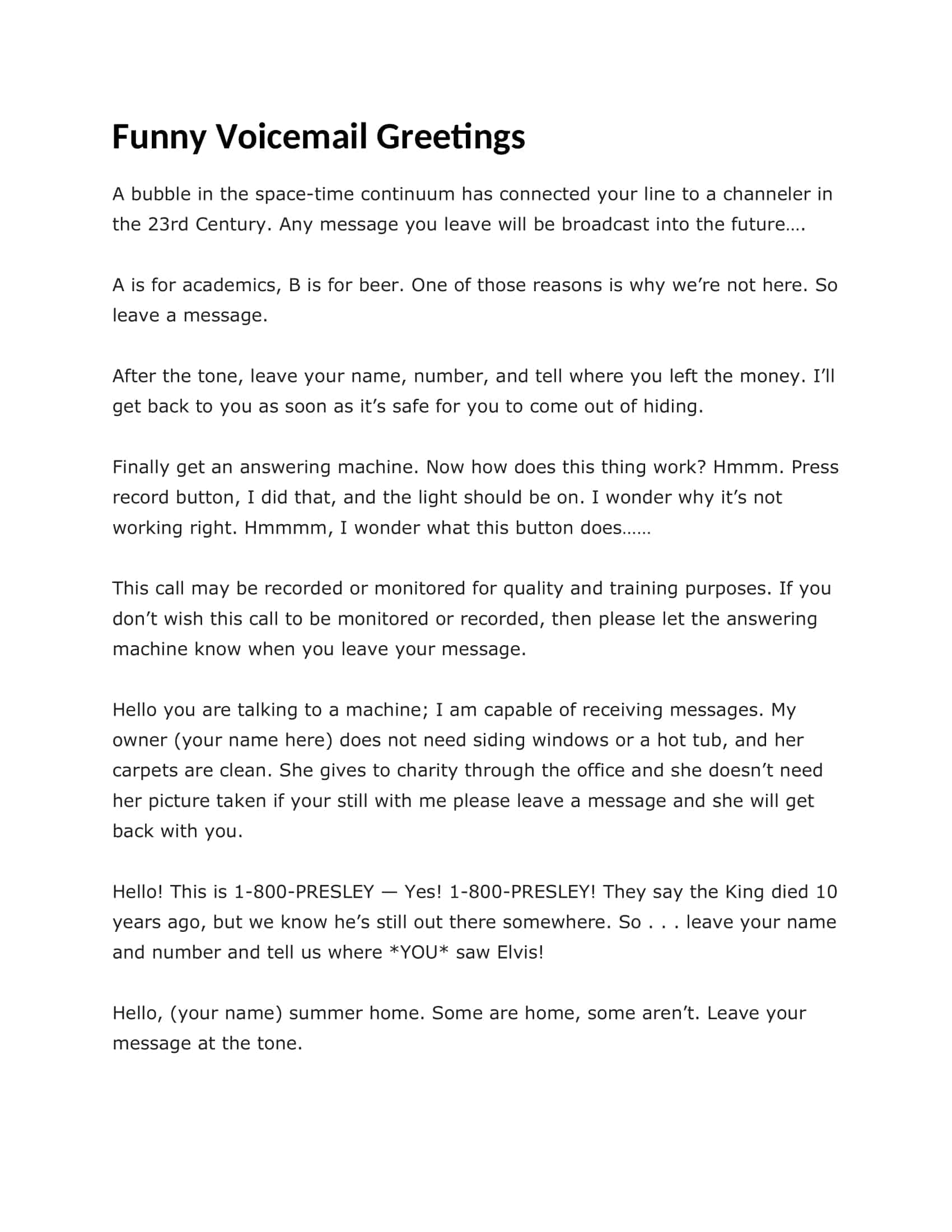

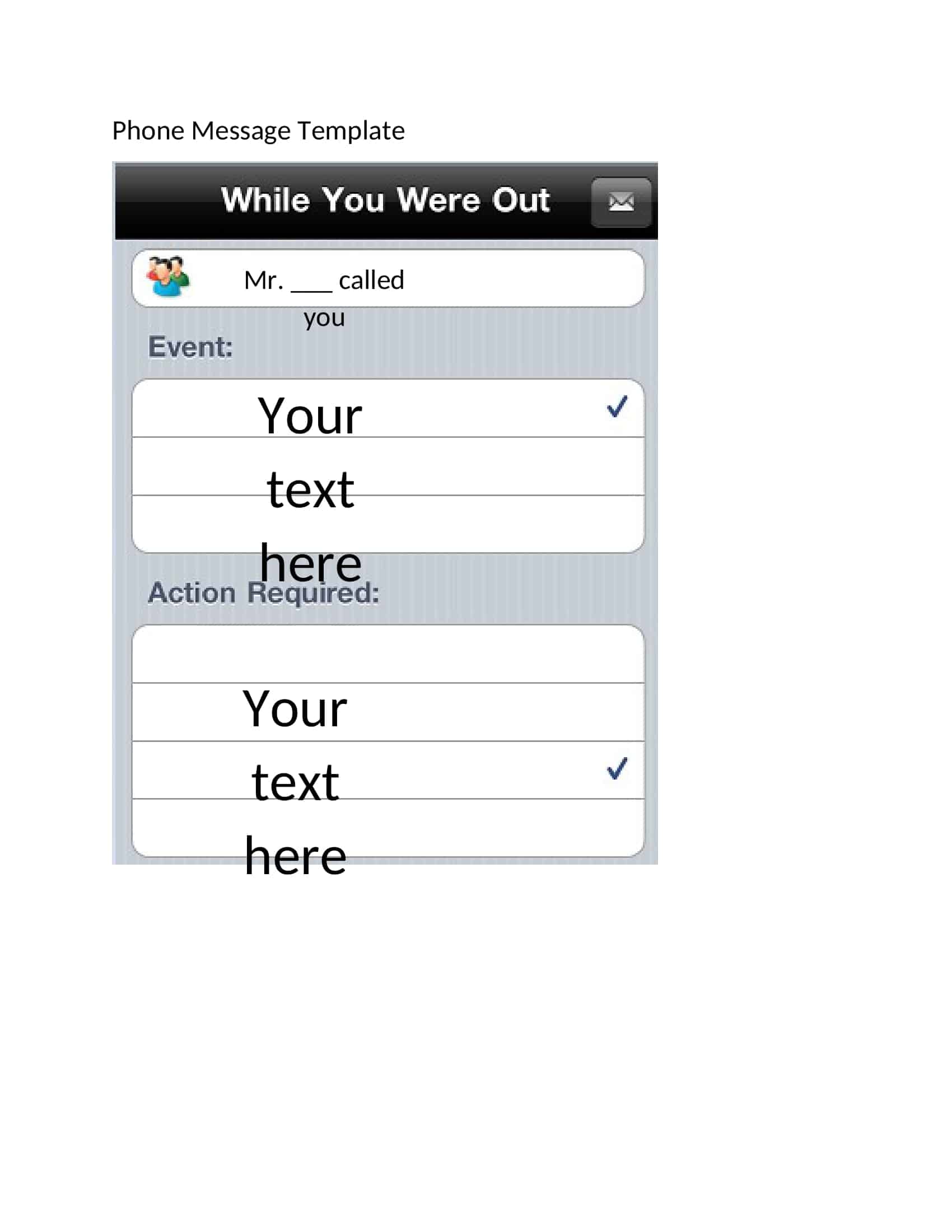
![%100 Free Hoodie Templates [Printable] +PDF 1 Hoodie Template](https://www.typecalendar.com/wp-content/uploads/2023/05/Hoodie-Template-1-150x150.jpg)
![Free Printable Food Diary Templates [Word, Excel, PDF] 2 Food Diary](https://www.typecalendar.com/wp-content/uploads/2023/05/Food-Diary-1-150x150.jpg 150w, https://www.typecalendar.com/wp-content/uploads/2023/05/Food-Diary-1-1200x1200.jpg 1200w)
![Free Printable Roommate Agreement Templates [Word, PDF] 3 Roommate Agreement](https://www.typecalendar.com/wp-content/uploads/2023/06/Roommate-Agreement-150x150.jpg)
